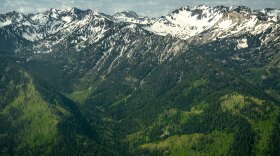-
The Trump administration wants to do away with the Roadless Area Conservation Rule. Established in 2001, it stopped road construction and logging on national forest lands — including four million acres in Utah.
-
In early May, St. George will build an electrical substation in a lot bursting with pieces of prehistoric fish, plants and dinosaurs. Paleontologists and volunteers are trying to salvage the fossils while they can.
-
Salt Lake City is planning to tear down the Fleet Block so it can redevelop the site. For families who have a loved one painted on the east building walls, it's a sacred memorial.
-
“We think of small businesses as being purely economic entities. If they have customers and if they have suppliers near them, they will all thrive. But that's not necessarily true,” said urban planning professor Divya Chandrasekhar.
-
The Northern Corridor Highway alternative route chosen by the Bureau of Land Management and U.S. Fish and Wildlife Service would avoid building a new road through prime Mojave Desert tortoise habitat.
-
Zone 6 is a popular recreation spot and desert tortoise habitat that was protected as part of the deal to build a highway near St. George. Local leaders and the state now say if the highway doesn’t happen, the land is open for business.
-
The county hopes to coordinate guidelines for maintaining and conserving the creeks on west side of the Salt Lake Valley that flow into the Great Salt Lake.
-
The bulk of funds will be allocated to widening roads and building new interchanges in counties across Utah.
-
The community-backed plan to turn the Rio Grande Depot back into a train station isn’t mentioned in newly released plans to redevelop the surrounding area.
-
Adding about 900 feet into the business core of Sugar House, and strategic double tracking of the existing line, is part of an effort to address the popular Salt Lake City neighborhood’s explosive growth.
-
Lawmaker and developer Brad Wilson bought land that would later benefit from its proximity to a major development supported by a $160 million tax incentive.
-
The Utah Legislature has the ability to overhaul zoning laws to pave the way for more affordable starter homes.
Play Live Radio
Next Up:
0:00
0:00
Available On Air Stations












